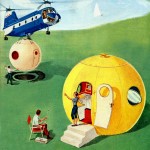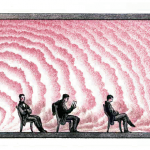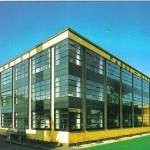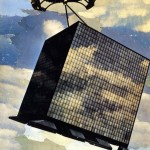The following is an illustrated review (on a 1974 number of Casabella), of a research on military architecture published by a group of students of the University of Bath.
Unfortunately the original article lacked a translation of the images’ captions. Due to the interesting informations they provide, we decided to present here their translation.
Of related interest:
Architecture in Uniform. Designing and Building for the Second World War. Jean-Louis Cohen.
Exhibition (on Domus, too).
Paul Virilio: Bunker Archaeology
Paul Virilio: the Negative Horizon. An Essay in Dromoscopy
Camouflage of Boeing plant in Seattle during World War II
First page:
1)Air defence aerostatic balloon over a mobile field during WW I (West front)
2)Section of an underground fortification according to a French model. The evolution of the domes was a direct result of technological advances of the artillery (new materials, more accurate shooting). Since 1910 the tendency was to abolish the large concentrated fortifications, replacing them with a system of forts with low domes and retractable cannons.
3)This direction was not followed by the Belgians who preferred to build huge and complicated fortresses (Liege and Namur) developed mostly on the surface, of rectangular shape with a diversified concentration of artillery; they proved unsuitable for a systematic defense of the long front, that in fact was defeated on the Belgian side.

Second page:
4)Plan of the trenches dug by the 126th British Infantry Regiment in the War of 1915-1918.
5)The most significant technical advances in terms of a possible use after war were made in the field of service facilities: field hospitals, prefabricated homes, mobile homes, sheds with a metal structure etc. In this series the phases of the assembly of a Weblee cabin with panels with a double layer of wooden boards with insulation and wooden centring.
6)The lesson of World War I imposes the necessity of a total defense of the territory. The imagination goes beyond the proposals of specialists assuming a collective space where you recreate, concentrated, the potential for social urban life. In the state of war the possibility of an underground life as a permanent condition must become desirable. The quality – as in cake – becomes a problem of layers (from a popular drawing on a 1936 Daily Express)
7/8)The codification of deception is represented by the vocation of the “military” to camouflage: men disguised as trees, casemates looking like dunes, etc. These examples of camouflage made on the English coast in 1940 use less natural fields to create a curiously untrustworthy urban camouflage . The Trojan Horse.

Third and fourth page:
9)Successive stages of placement of a British naval fortress. The bottom of the cylinders is filled with water, letting the platform sink and sit on the bottom of the sea.
10)Integrated air defense towers. Technology surpasses the utopia checking out the possibility of non-terrestrial architecture.
11)Observation post with broad horizontal slit along the coast of Cherbourg.
12)Picture of the current state of a casemate of the Atlantic Wall near Brest. The camouflage was obtained with a very rough layer of plaster. The constructions of the Atlantic Wall are, from the formal and technical point of view, the clearer example of analogy and continuity with the military architecture of the Renaissance. The forms were in fact designed to deflect bullets rather than curb their impulse.
13)The system of radar towers and antiaircraft batteries in Wien.
14)Two towers for anti-aircraft batteries (flak towers) still existing in Vienna. Bunkers-shelters for the civilian population are located in the area below the cornice molding, of a thickness of about a meter and a half.
15)The subterranean condition becomes a figurative constant of war culture, transforming environments and objects according to the exceptional conditions. Rest room for the medical staff of the undergound hospital of New Jersey.
16)The bed-shelter Heals.
17)In the reassuring journalism of wartime, the ideology of the shelter has its own particular iconography. While the house is burning you can chat, watch the fire and host friends. In this macabre contrast, destruction and war belong to the category of natural disasters against which you try just to survive … to begin again as before.







Leave a Reply